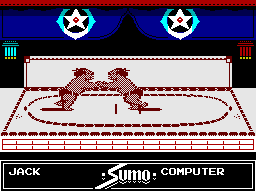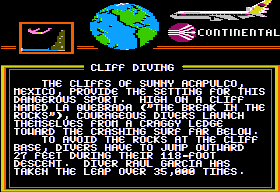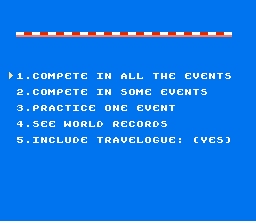Retro Replay Review
Gameplay
World Games delivers a collection of eight diverse, arcade-style events that capture the feel of an international sports festival. From barrel jumping to weightlifting, each discipline demands a distinct set of timing and reflex skills. Players will find themselves mastering the delicate balance of button taps and joystick movements, whether they’re launching over barrels or grappling in sumo wrestling. The arcade sensibility means events are fast-paced and forgiving enough for newcomers, yet rich with depth for seasoned players seeking perfect runs.
(HEY YOU!! We hope you enjoy! We try not to run ads. So basically, this is a very expensive hobby running this site. Please consider joining us for updates, forums, and more. Network w/ us to make some cash or friends while retro gaming, and you can win some free retro games for posting. Okay, carry on 👍)
On the Sega Master System, the roster is trimmed to four events—barrel jumping, bull riding, caber toss, and pole vault—yet these disciplines still showcase the same addictive, pick-up-and-play action. Barrel jumping tests your sense of momentum as you guide your rider across an ever-increasing line of barrels. Bull riding is a wild test of reflex, asking you to stay balanced atop a bucking beast. Caber toss, with its unique angle-based challenge, rewards precision and patience. Finally, the pole vault adds a sprint-and-launch combination that feels surprisingly dynamic on 8-bit hardware.
Multiplayer modes shine as the true heart of World Games’ gameplay, turning each event into a lively competition among friends. Passing the controller or connecting two consoles offers head-to-head action that can become fiercely competitive, especially in events like log rolling and sumo wrestling. While single-player high-score chases provide plenty of replay value, it’s the shared thrill of landing a perfect dive or setting a bench press record that cements World Games as an arcade staple for group play.
Graphics
Visually, World Games embraces the bright, bold palette characteristic of late ’80s sports titles. On 8-bit systems, sprites are chunky but well-animated, giving each athlete a distinct silhouette and personality. Barrel jumping shows your rider’s legs kicking with enough clarity that you can anticipate each vault’s landing. In bull riding, the bull’s unpredictable head bobs and tail swishes convey the animal’s wild nature, adding both challenge and charm.
The backgrounds are simple yet effective, often featuring cheering pixel crowds or sweeping mountain vistas for events like skiing and cliff diving. While these set pieces don’t compete with 16-bit consoles, they nonetheless provide a spirited atmosphere. During the caber toss, for instance, a lush green field serves as a neutral stage where the motion of the log stands out crisply. The contrast between athlete and environment remains clear, ensuring gameplay readability at all times.
On the Master System, the reduced event roster allows the hardware to push for slightly cleaner animation frames and smoother scrolling, especially in pole vault and bull riding. Each event still feels visually distinctive despite the smaller color range. Special effects—such as dust clouds on ski slopes or the flash of a weightlifting barbell—add just enough flair to keep the eye engaged without overwhelming the core action.
Story
True to its arcade roots, World Games forgoes a traditional narrative in favor of pure competition. There is no overarching plot or character backstory; instead, the “story” unfolds as you progress through each nation’s event lineup. The sense of advancement comes from defeating local records and moving on to more challenging arenas. This approach focuses attention squarely on skill development and personal achievement.
What World Games lacks in cinematic storytelling, it makes up for with the thrill of international rivalry. Each represented country boasts its own leaderboard, creating an implicit storyline of underdog athletes rising to glory or champions defending their titles. This unspoken narrative encourages players to adopt a national banner and invest emotionally in each event’s outcome, turning a simple high-score chase into a journey of athletic pride.
Occasional cutscenes—such as a victorious athlete ripping off their weightlifting belt or a diver taking a celebratory bow—provide brief but satisfying bookends to your performances. These moments, though minimal, reinforce the sense of accomplishment that defines World Games. In an era before deep narrative integration in sports titles, this light-touch approach feels appropriate and unobtrusive, letting the gameplay speak for itself.
Overall Experience
World Games remains a testament to the timeless appeal of arcade sports collections. Its varied roster of events ensures no two sessions feel alike, and the easy-to-learn, hard-to-master control scheme keeps players coming back. Whether you’re aiming to perfect your caber toss or dominate the bull riding arena, there’s a consistent thrill in mastering each challenge and chasing new personal bests.
The Sega Master System version, while limited to four events, still captures the essence of the original with tight controls and colorful presentation. It’s an ideal pick for retro enthusiasts or families seeking quick bursts of multiplayer excitement. Even solo players will appreciate the game’s unlockable records and escalating difficulty, which reward patience and practice.
In today’s landscape of hyper-realistic sports simulators, World Games offers a refreshing, nostalgia-fueled alternative. It distills the competitive spirit of global athletic festivals into bite-sized, high-energy events that remain as engaging now as they were at release. For anyone seeking arcade-style fun or a compact party game for friends, World Games stands out as a classic worth revisiting—or discovering for the first time.
 Retro Replay Retro Replay gaming reviews, news, emulation, geek stuff and more!
Retro Replay Retro Replay gaming reviews, news, emulation, geek stuff and more!









Reviews
There are no reviews yet.